Selecting Disaster Waste Transportation Routes to Reduce Overlapping of Transportation Routes after Floods
Abstract
:1. Introduction
2. Literature Review
2.1. Critical Facility and Emergency Response Activities
“Critical facilities commonly include all public and private facilities that a community considers essential for the delivery of vital services and for the protection of the community. They usually include emergency response facilities (fire stations, police stations, rescue squads, and emergency operation centers [EOCs]), custodial facilities (jails and other detention centers, long-term care facilities, hospitals, and other health care facilities), schools, emergency shelters, utilities (water supply, wastewater treatment facilities, and power), communications facilities, and any other assets determined by the community to be of critical importance for the protection of the health and safety of the population”.[18]
2.2. Flood Impact on People and Vehicles in Experimental Research
3. Material and Methods
4. Results
4.1. Disaster Waste Transportation Routes in the Response Phase
4.2. Disaster Waste Transportation Routes in the Response Phase
5. Discussion
5.1. Routes of Dispatching Services to Secure Urban Functions in Each Disaster Phase
5.2. Research Limitations and Future Research Directions
6. Conclusions
Author Contributions
Funding
Institutional Review Board Statement
Informed Consent Statement
Data Availability Statement
Conflicts of Interest
Appendix A
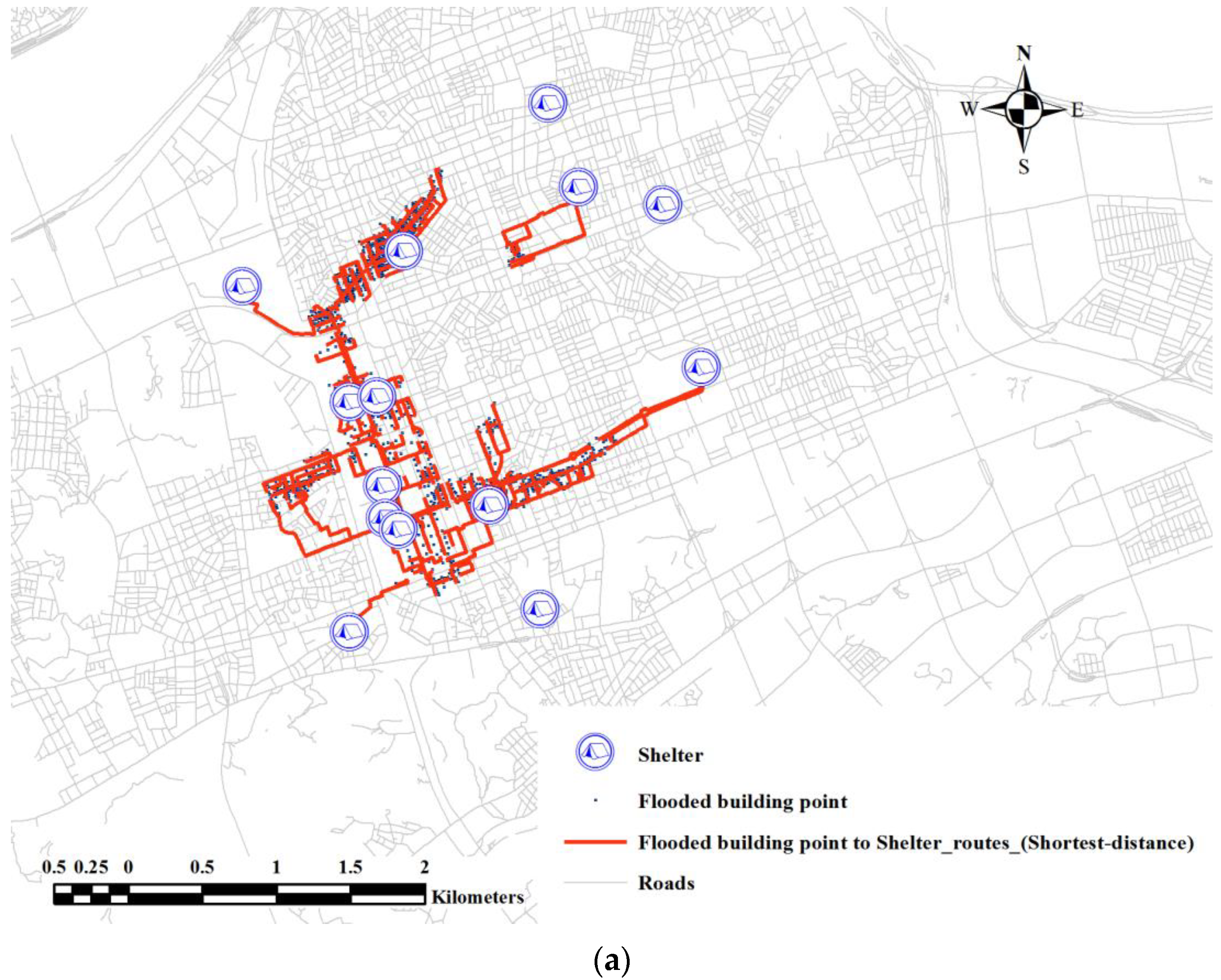
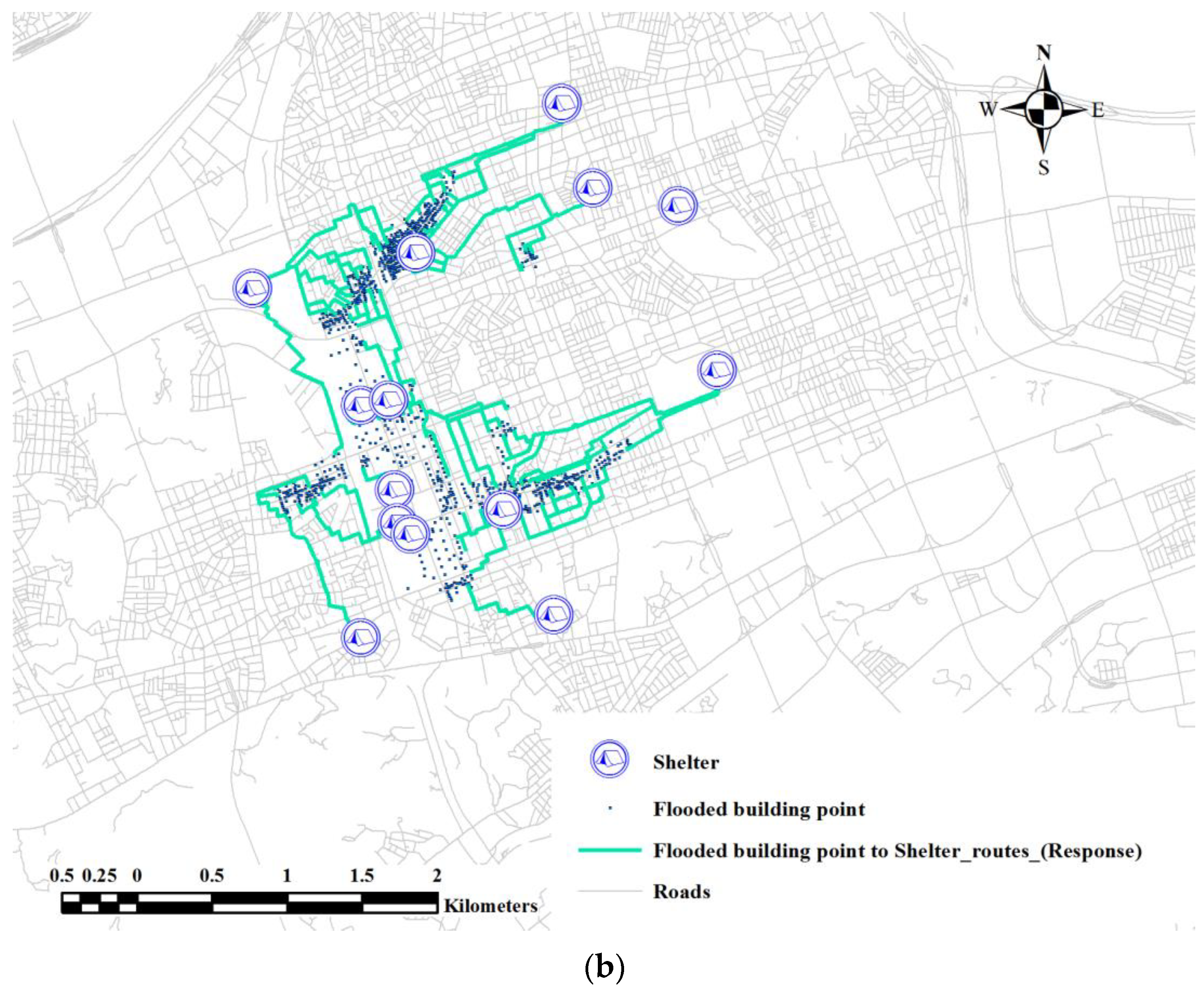
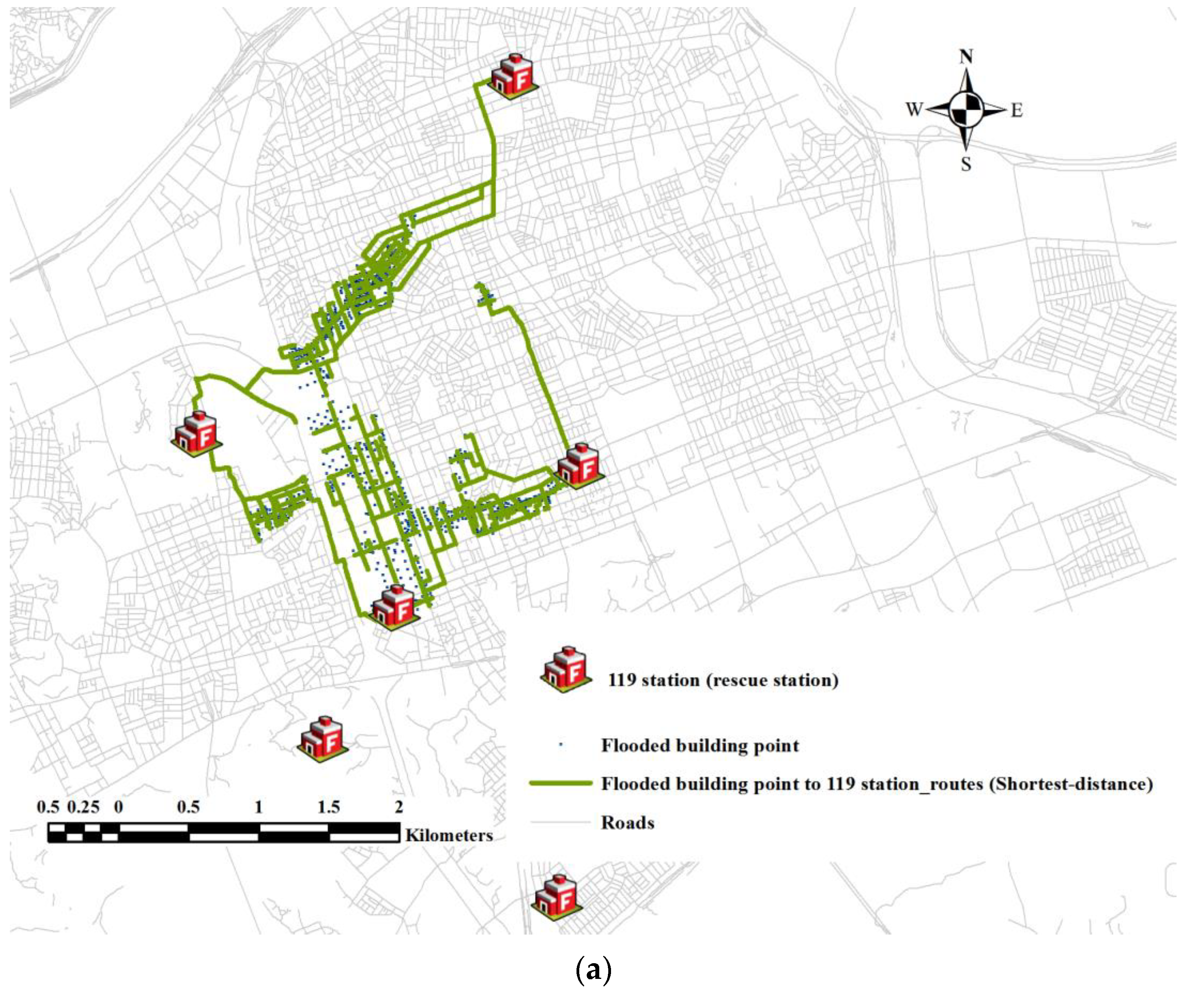


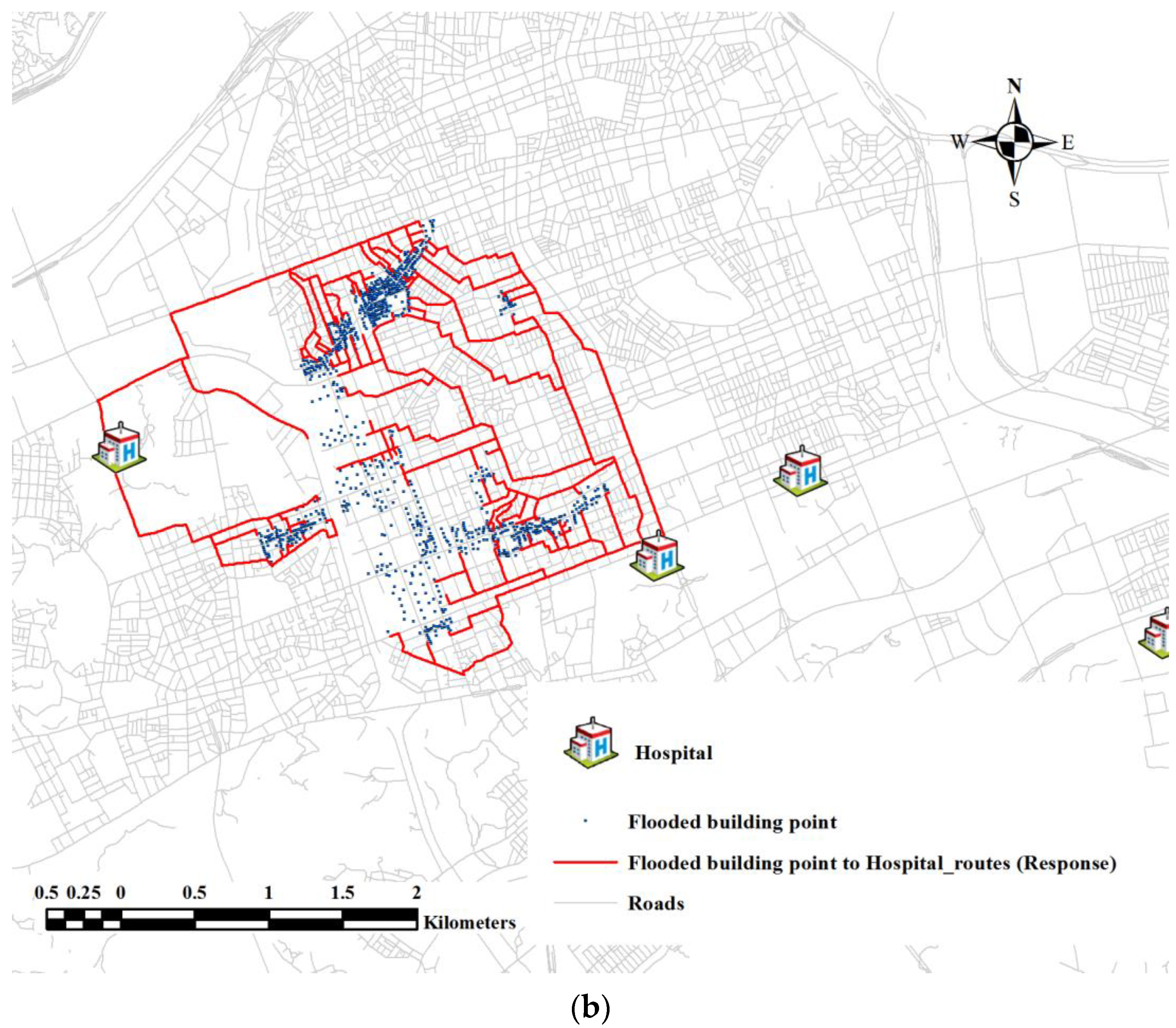
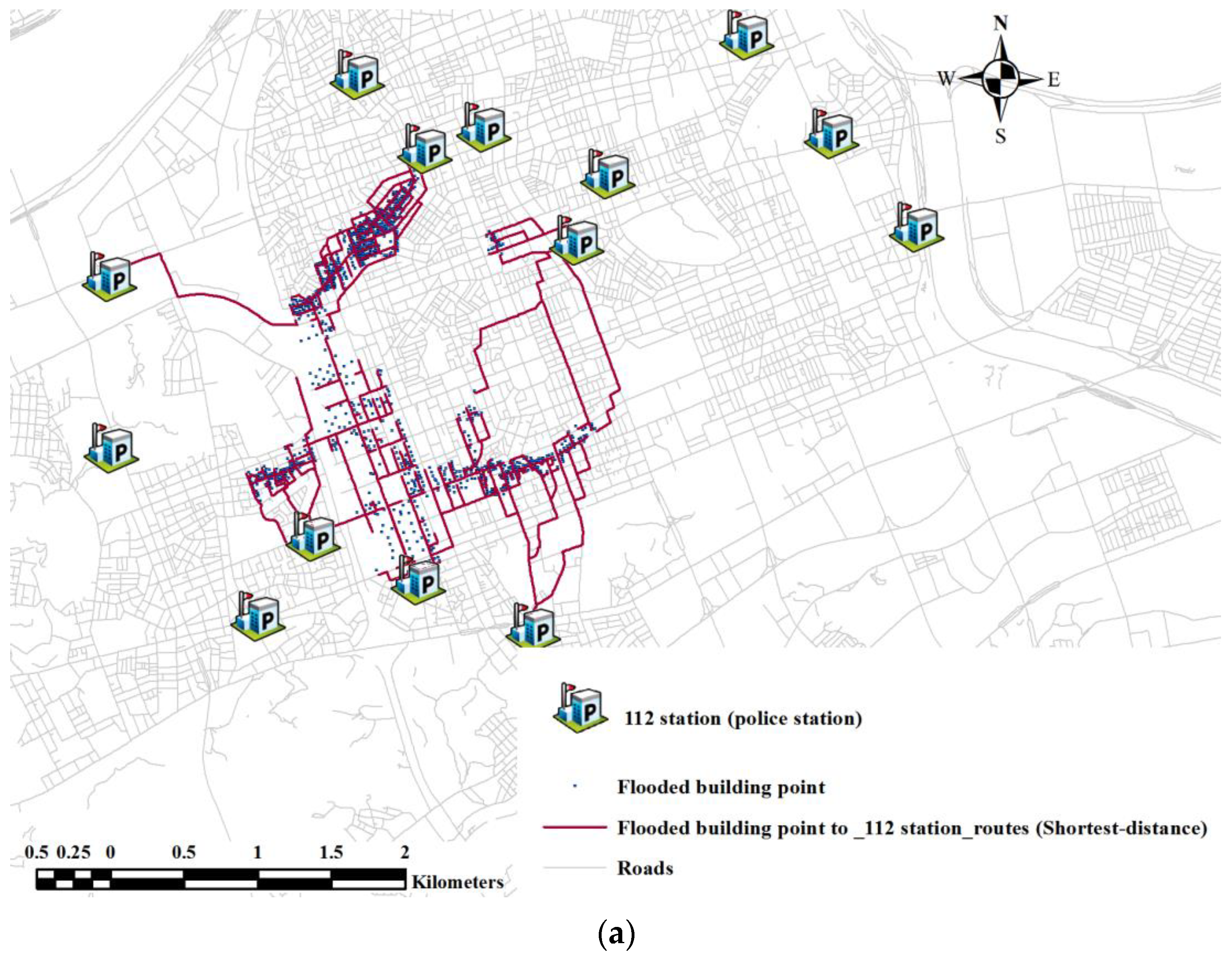


References
- Jha, A.K.; Bloch, R.; Lamond, J. Cities and Flooding: A Guide to Integrated Urban Flood Risk Management for the 21st Century; The World Bank: Washington, DC, USA, 2012. [Google Scholar]
- Brown, C.; Milke, M.; Seville, E. Disaster waste management: A review article. Waste Manag. 2011, 31, 1085–1098. [Google Scholar] [CrossRef] [PubMed] [Green Version]
- Hayes, J.L.; Wilson, T.M.; Brown, C.; Deligne, N.I.; Leonard, G.S.; Cole, J. Assessing urban disaster waste management requirements after volcanic eruptions. Int. J. Disaster Risk Reduct. 2021, 52, 101935. [Google Scholar] [CrossRef]
- Cheng, C.; Zhu, R.; Costa, A.M.; Thompson, R.G.; Huang, X. Multi-period two-echelon location routing problem for disaster waste clean-up. Transp. A Transp. Sci. 2021, 1–31. [Google Scholar] [CrossRef]
- Crowley, J. A measurement of the effectiveness and efficiency of pre-disaster debris management plans. Waste Manag. 2017, 62, 262–273. [Google Scholar] [CrossRef]
- Takeda, T.; Mori, Y.; Kubota, N.; Arai, Y. A route planning for disaster waste disposal based on robot technology. In Proceedings of the 2014 IEEE Symposium on Robotic Intelligence in Informationally Structured Space (RiiSS), Orlando, FL, USA, 9–12 December 2014; pp. 1–6. [Google Scholar]
- Amal, L.; Chabchoub, H. SGA: Spatial GIS-based genetic algorithm for route optimization of municipal solid waste collection. Environ. Sci. Pollut. Res. 2018, 25, 27569–27582. [Google Scholar] [CrossRef] [PubMed]
- Cheng, C.; Zhu, R.; Costa, A.M.; Thompson, R.G. Optimisation of waste clean-up after large-scale disasters. Waste Manag. 2021, 119, 1–10. [Google Scholar] [CrossRef]
- Cheng, C.; Zhang, L.; Thompson, R.G. Reliability analysis of road networks in disaster waste management. Waste Manag. 2019, 84, 383–393. [Google Scholar] [CrossRef] [PubMed]
- Hu, Z.H.; Sheu, J.B.; Wei, C.; Hu, S.L. Post-storm debris removal considering traffic and psychological impacts. Transp. A Transp. Sci. 2019, 15, 1145–1174. [Google Scholar] [CrossRef]
- Pramudita, A.; Taniguchi, E. Model of debris collection operation after disasters and its application in urban area. Int. J. Urban Sci. 2014, 18, 218–243. [Google Scholar] [CrossRef]
- Hu, Z.H.; Sheu, J.B. Post-disaster debris reverse logistics management under psychological cost minimization. Transp. Res. Part B Methodol. 2013, 55, 118–141. [Google Scholar] [CrossRef]
- Gao, X.; Cao, C. Multi-commodity rebalancing and transportation planning considering traffic congestion and uncertainties in disaster response. Comput. Ind. Eng. 2020, 149, 106782. [Google Scholar] [CrossRef]
- Liu, Y.; Yuan, Y.; Shen, J.; Gao, W. Emergency response facility location in transportation networks: A literature review. J. Traffic Transp. Eng. 2021, 8, 153–169. [Google Scholar] [CrossRef]
- Sahin, H.; Kara, B.Y.; Karasan, O.E. Debris removal during disaster response: A case for Turkey. Socio-Econ. Plan. Sci. 2016, 53, 49–59. [Google Scholar] [CrossRef] [Green Version]
- Parizi, S.M.; Taleai, M.; Sharifi, A. Integrated methods to determine urban physical resilience characteristics and their interactions. Nat. Hazards 2021, 109, 725–754. [Google Scholar] [CrossRef]
- Berktaş, N.; Kara, B.Y.; Karaşan, O.E. Solution methodologies for debris removal in disaster response. EURO J. Comput. Optim. 2016, 4, 403–445. [Google Scholar] [CrossRef] [Green Version]
- Federal Emergency Management Agency. Design Guide for Improving Critical Facility Safety from Flooding and High Winds: Providing Protection to People and Buildings; FEMA: Washington, DC, USA, 2007.
- Alizadeh, H.; Sharifi, A. Assessing resilience of urban critical infrastructure networks: A case study of Ahvaz, Iran. Sustainability 2020, 12, 3691. [Google Scholar] [CrossRef]
- Nan, C.; Sansavini, G. A quantitative method for assessing resilience of interdependent infrastructures. Reliab. Eng. Syst. 2017, 157, 35–53. [Google Scholar] [CrossRef]
- Cimellaro, G.P.; Renschler, C.; Reinhorn, A.M.; Arendt, L. PEOPLES: A framework for evaluating resilience. J. Struct. Eng. 2016, 142, 04016063. [Google Scholar] [CrossRef]
- Yin, J.; Yu, D.; Liao, B. A city-scale assessment of emergency response accessibility to vulnerable populations and facilities under normal and pluvial flood conditions for Shanghai, China. Environ. Plan B Urban Anal. City Sci. 2021, 48, 2239–2253. [Google Scholar] [CrossRef]
- Hino, K.; Tanaka, Y.; Schneider, R.H. Characteristics of fear of crime in evacuation shelters after the Great East Japan Earthquake. Environ. Hazards 2018, 17, 456–469. [Google Scholar] [CrossRef]
- Bolin, R.; Stanford, L. Shelter, housing and recovery: A comparison of U.S. disasters. Disasters 1991, 15, 24–34. [Google Scholar] [CrossRef]
- Rahill, G.J.; Ganapati, N.E.; Clérismé, J.C.; Mukherji, A. Shelter recovery in urban Haiti after the earthquake: The dual role of social capital. Disasters 2014, 38, S73–S93. [Google Scholar] [CrossRef] [PubMed]
- Brodie, M.; Weltzien, E.; Altman, D.; Blendon, R.J.; Benson, J.M. Experiences of Hurricane Katrina evacuees in Houston shelters: Implications for future planning. Am. J. Public Health 2006, 96, 1402–1408. [Google Scholar] [CrossRef] [PubMed]
- Farmer, A.K.; Zelewicz, L.; Wachtendorf, T.; DeYoung, S.E. Scared of the shelter from the storm: Fear of crime and hurricane shelter decision making. Sociol. Inq. 2018, 88, 193–215. [Google Scholar] [CrossRef]
- Matsuo, K.; Natainia, L.; Yamada, F. Flood and evacuation simulations for urban flooding. In Proceedings of the 5th International Conference on Flood Management, Tokyo, Japan, 27–29 September 2011; pp. 391–398. [Google Scholar]
- Kang, S.-H. Study on refuge behavior and its critical inundation depth in low area. KSCE 2003, 23, 561–565. [Google Scholar]
- DEFRA and the Environment Agency. R&D Outputs: Flood Risks to People. Phase 2. FD2321/TR1 The Flood Risks to People Methodology; Department for Environment Food and Rural Affairs and the Environment Agency: London, UK, 2006.
- Ishigaki, T. Evacuation criteria during urban flooding in underground space. In Proceedings of the 11st ICUD, Scotland, UK, 31 August–5 September 2008. [Google Scholar]
- Ishigaki, T.; Baba, Y.; Toda, K.; Inoue, K. Experimental study on evacuation from underground space in urban flood. In Proceedings of the Korea Water Resources Association Conference, Iksan, Korea, 20–21 May 2005. [Google Scholar]
- Lee, H.K.; Hong, W.H.; Lee, Y.H. Experimental study on the influence of water depth on the evacuation speed of elderly people in flood conditions. Int. J. Disaster Risk Reduct 2019, 39, 101198. [Google Scholar] [CrossRef]
- Bernardini, G.; Quagliarini, E.; D’Orazio, M.; Brocchini, M. Towards the simulation of flood evacuation in urban scenarios: Experiments to estimate human motion speed in floodwaters. Saf. Sci. 2020, 123, 104563. [Google Scholar] [CrossRef]
- Dias, C.; Abd Rahman, N.; Zaiter, A. Evacuation under flooded conditions: Experimental investigation of the influence of water depth on walking behaviors. Int. J. Disaster Risk Reduct. 2021, 58, 102192. [Google Scholar] [CrossRef]
- Lee, Y.H.; Keum, H.J.; Han, K.Y.; Hong, W.H. A hierarchical flood shelter location model for walking evacuation planning. Environ. Hazards 2021, 20, 432–455. [Google Scholar] [CrossRef]
- Pregnolato, M.; Ford, A.; Wilkinson, S.M.; Dawson, R.J. The impact of flooding on road transport: A depth-disruption function. Transp. Res. Part D Transp. Environ. 2017, 55, 67–81. [Google Scholar] [CrossRef]
- Smith, G.P.; Modra, B.D.; Tucker, T.A.; Cox, R.J. Vehicle Stability Testing for Flood Flows; UNSW Water Research Laboratory: Sydney, Australia, 2017. [Google Scholar]
- Kramer, M.; Terheiden, K.; Wieprecht, S. Safety criteria for the trafficability of inundated roads in urban floodings. Int. J. Disaster Risk Reduct. 2016, 17, 77–84. [Google Scholar] [CrossRef] [Green Version]
- Falcocchio, J.C.; Levinson, H.S. Road Traffic Congestion: A Concise Guide; Springer: Berlin/Heidelberg, Germany, 2015; Volume 7. [Google Scholar]
- Kasmalkar, I.; Suckale, J. Traffic accidents and delays present contrasting pictures of traffic resilience to coastal flooding in the San Francisco, Bay Area, USA. Urban Clim. 2021, 37, 100851. [Google Scholar] [CrossRef]
- Kasmalkar, I.G.; Serafin, K.A.; Miao, Y.; Bick, I.A.; Ortolano, L.; Ouyang, D.; Suckale, J. When floods hit the road: Resilience to flood-related traffic disruption in the San Francisco Bay Area and beyond. Sci. Adv. 2020, 6, eaba2423. [Google Scholar] [CrossRef] [PubMed]
- Esri. Barriers. Available online: https://desktop.arcgis.com/en/arcmap/latest/extensions/network-analyst/barriers.htm (accessed on 21 January 2022).
- Lee, Y.H.; Kim, Y.C.; Lee, H.K. Framework for selection of temporary disaster waste management sites for post-flood recovery in Seoul, South Korea. Int. J. Disaster Risk Reduct. 2022, 71, 102832. [Google Scholar] [CrossRef]
- Cutter, S.; Ismail-Zadeh, A.; Alcántara-Ayala, I.; Altan, O.; Baker, D.N.; Briceño, S.; Gupt, H.; Holloway, A.; Johnston, D.; McBean, G.A.; et al. Global risks: Pool knowledge to stem losses from disasters. Nature 2015, 522, 277–279. [Google Scholar] [CrossRef]
- Francini, M.; Artese, S.; Gaudio, S.; Palermo, A.; Viapiana, M.F. To support urban emergency planning: A GIS instrument for the choice of optimal routes based on seismic hazards. Int. J. Disaster Risk Reduct. 2018, 31, 121–134. [Google Scholar] [CrossRef]
- Artese, S.; Achilli, V. A gis tool for the management of seismic emergencies in historical centers: How to choose the optimal routes for civil protection interventions. ISPRS Ann. Photogramm. Remote Sens. Spat. Inf. Sci. 2019, 42, 99–106. [Google Scholar] [CrossRef] [Green Version]
- Nguyen, D.T.; Shen, Z.J.; Truong, M.H.; Sugihara, K. Improvement of Evacuation Modeling by Considering Road Blockade in the Case of an Earthquake: A Case Study of Daitoku School District, Kanazawa City, Japan. Sustainability 2021, 13, 2637. [Google Scholar] [CrossRef]
- Kocatepe, A.; Ulak, M.B.; Kakareko, G.; Ozguven, E.E.; Jung, S.; Arghandeh, R. Measuring the accessibility of critical facilities in the presence of hurricane-related roadway closures and an approach for predicting future roadway disruptions. Nat. Hazards 2019, 95, 615–635. [Google Scholar] [CrossRef]
- Salimi, M.; Al-Ghamdi, S.G. Climate change impacts on critical urban infrastructure and urban resiliency strategies for the Middle East. Sustain. Cities Soc. 2020, 54, 101948. [Google Scholar] [CrossRef]
- Molaei, P.; Tang, L.; Hardie, M. Measuring walkability with street and physical activity: A case study in Iran. World 2021, 2, 4. [Google Scholar] [CrossRef]
- Hooper, E.; Chapman, L.; Quinn, A. Investigating the impact of precipitation on vehicle speeds on UK motorways. Meteorol. Appl. 2014, 21, 194–201. [Google Scholar] [CrossRef]
- Chung, Y. Assessment of non-recurrent congestion caused by precipitation using archived weather and traffic flow data. Transp. Policy 2012, 19, 167–173. [Google Scholar] [CrossRef]
- Smith, B.L.; Byrne, K.G.; Copperman, R.B.; Hennessy, S.M.; Goodall, N.J. An investigation into the impact of rainfall on freeway traffic flow. In Proceedings of the 83rd Annual meeting of the Transportation Research Board, Washington, DC, USA, 11–15 January 2004; Citeseer: Princeton, NJ, USA. [Google Scholar]
- Sabir, M.; van Ommeren, J.; Koetse, M.; Rietveld, P. Welfare Effects of Adverse Weather through Speed Changes on Car Commuting Trips; Vu University: Amsterdam, The Netherlands, 2008. [Google Scholar]
- Sharifi, A. Resilient urban forms: A review of literature on streets and street networks. Build. Environ. 2019, 147, 171–187. [Google Scholar] [CrossRef]



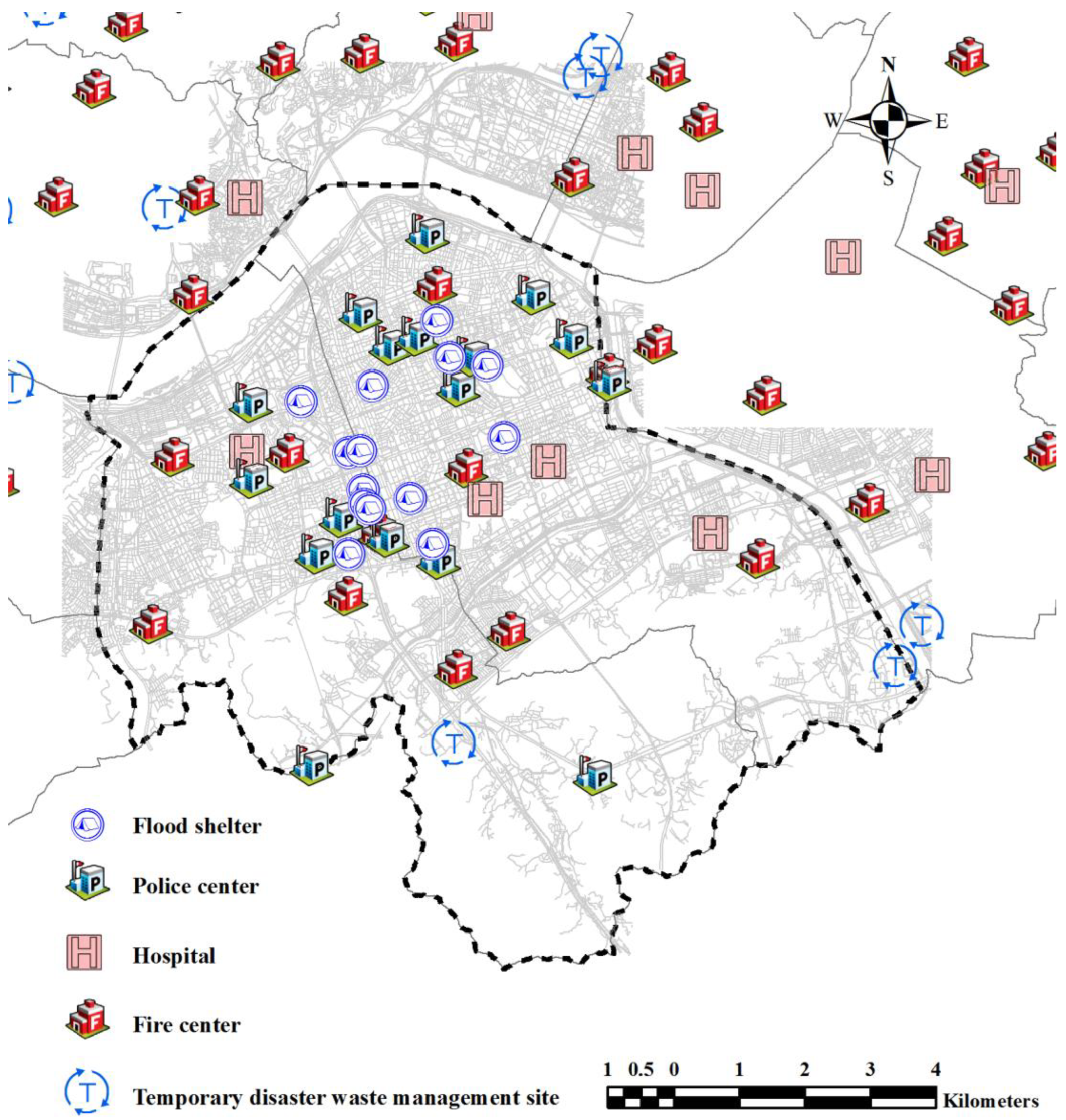
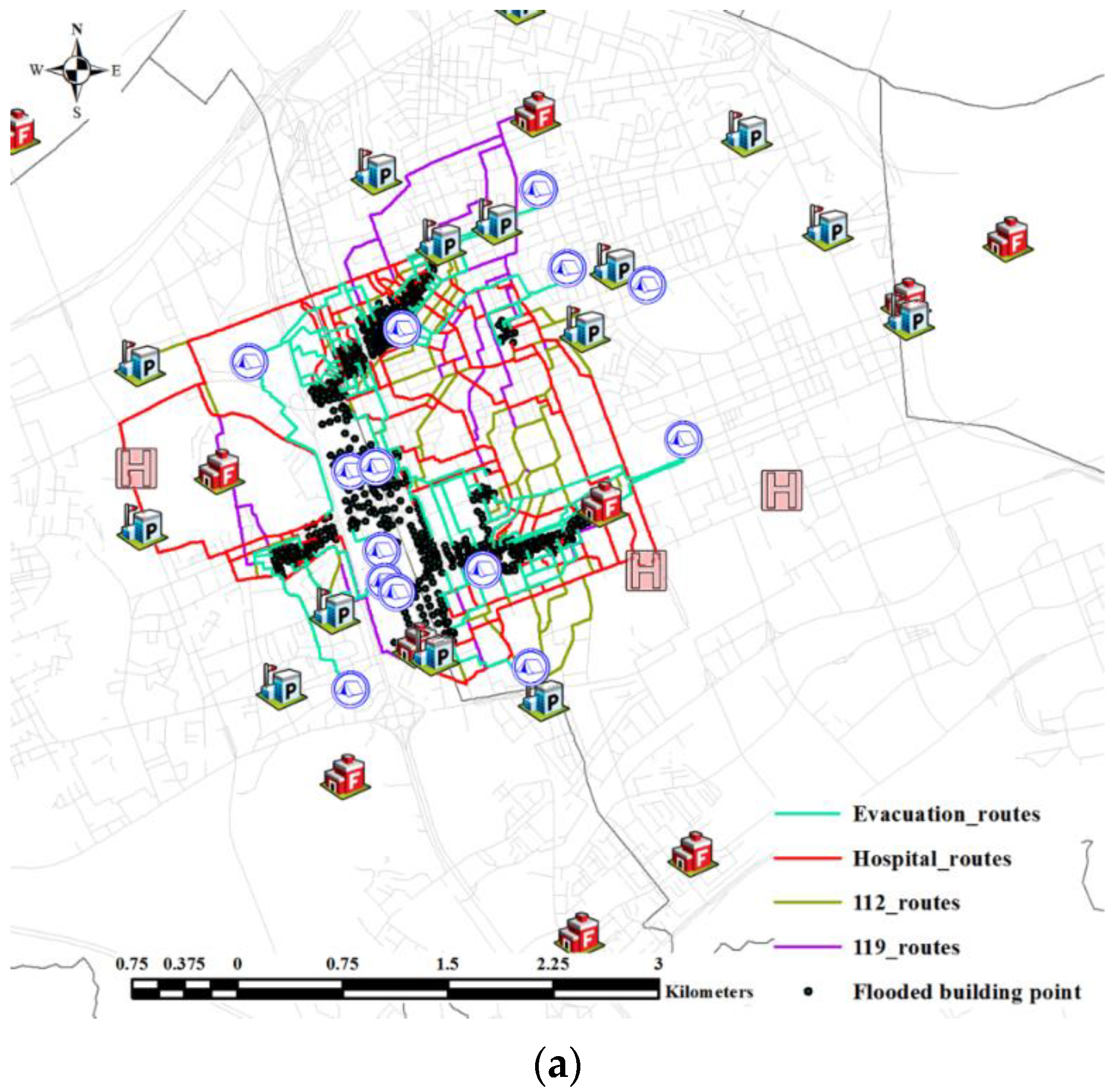




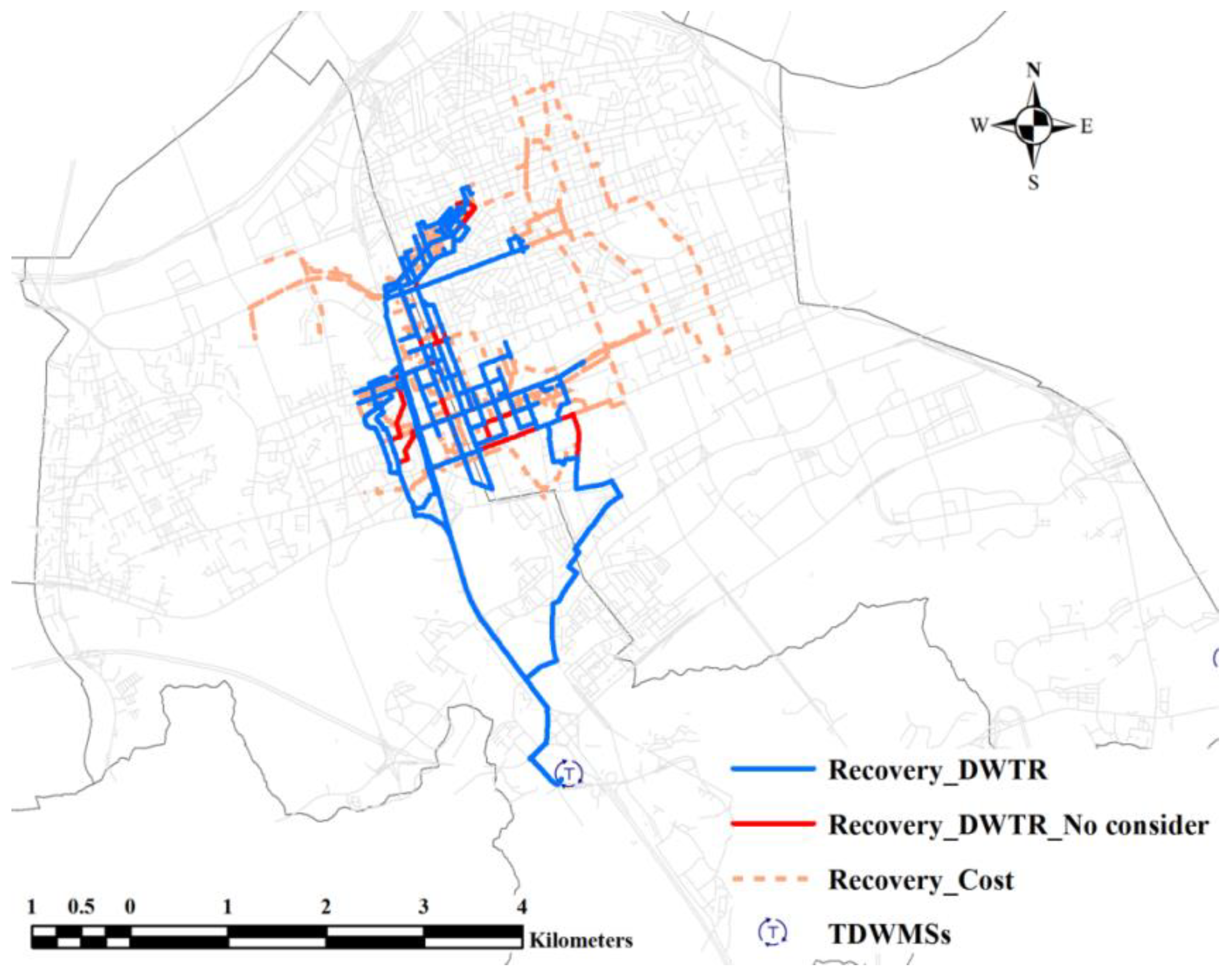
| Disaster Circumstance | Major Routes for Providing Critical Services | Disaster Waste Transportation Routes | |
|---|---|---|---|
| Response phase | A situation where the flood water is quite deep | Movement from critical facilities to flooded buildings | Movement between flooded buildings and the temporary disaster waste management site (TDWMS) |
| Recovery phase | A situation where the flood water has receded and the inundation depth is shallow or almost zero | Movement from critical facilities to evacuation facilities | Movement between flooded buildings and the TDWMS |
| People | Vehicles | |
|---|---|---|
| Response phase | Evacuation is assumed to be difficult, when the inundation depth is greater than or equal to 30 cm. | Operating vehicles * is considered difficult for rescue/aid and police services, when the inundation depth is greater than or equal to 30 cm. |
| Operating vehicles * is considered difficult to remove and transport wastes, when the inundation depth is greater than or equal to 50 cm. | ||
| Recovery phase | The flood water is assumed to have receded, no longer affecting walking. | The flood water is assumed to have receded, no longer affecting the vehicle operation. |
| Minimum | Maximum | Mean | Length of Overlap Sections with Critical Service Provision Routes | |
|---|---|---|---|---|
| Shortest distance | 4354.43 m | 8984.94 m | 7659.33 m | 256,626.49 m |
| Shortest distance of the routes with the minimum overlaps | 4354.43 m | 21,619.68 m | 10,252.60 m | 134,758.91 m |
| Increasing/decreasing rate (%) | 0.00 | ▲58.44 | ▲25.29 | ▼47.49 |
| Minimum | Maximum | Mean | Length of Overlap Sections with Critical Service Provision Routes | |
|---|---|---|---|---|
| Shortest distance | 4354.43 m | 7449.11 m | 5976.14 m | 525,859.53 m |
| Shortest distance of the routes with the minimum overlaps | 4699.97 m | 12,089.68 m | 6625.14 m | 233,657.63 m |
| Increasing/decreasing rate (%) | ▲7.35 | ▲38.38 | ▲9.80 | ▼55.57 |
Publisher’s Note: MDPI stays neutral with regard to jurisdictional claims in published maps and institutional affiliations. |
© 2022 by the authors. Licensee MDPI, Basel, Switzerland. This article is an open access article distributed under the terms and conditions of the Creative Commons Attribution (CC BY) license (https://creativecommons.org/licenses/by/4.0/).
Share and Cite
Lee, Y.-H.; Kim, Y.-C.; Seo, H. Selecting Disaster Waste Transportation Routes to Reduce Overlapping of Transportation Routes after Floods. Sustainability 2022, 14, 2866. https://doi.org/10.3390/su14052866
Lee Y-H, Kim Y-C, Seo H. Selecting Disaster Waste Transportation Routes to Reduce Overlapping of Transportation Routes after Floods. Sustainability. 2022; 14(5):2866. https://doi.org/10.3390/su14052866
Chicago/Turabian StyleLee, Yoon-Ha, Young-Chan Kim, and Hyuncheol Seo. 2022. "Selecting Disaster Waste Transportation Routes to Reduce Overlapping of Transportation Routes after Floods" Sustainability 14, no. 5: 2866. https://doi.org/10.3390/su14052866
APA StyleLee, Y.-H., Kim, Y.-C., & Seo, H. (2022). Selecting Disaster Waste Transportation Routes to Reduce Overlapping of Transportation Routes after Floods. Sustainability, 14(5), 2866. https://doi.org/10.3390/su14052866







